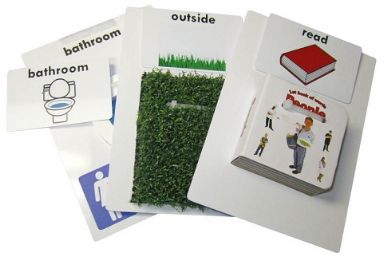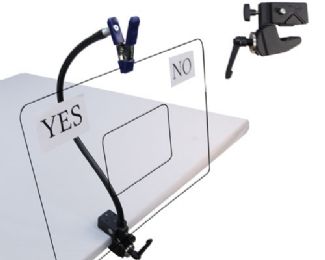


First, Some Basics About Assistive Technology and AAC
The devices in this category all can be considered Augmentative and Alternative Communication, or AAC.
Simply put, any device, method or system that improves the ability of a child with a communication impairment to communicate effectively falls under this umbrella.
The technology-driven devices in this category use pre-recorded messages to enable the child to socialize, communicate needs, ask questions and anticipate events. They require no speech input to operate.
What Do Technology-Based AAC Devices Do?
To use an alternative communication device, individualized messages are recorded into the device, matching picture icons, words or colors, depending on the child’s ability level and the purpose for which the device is being used.
The child can then answer questions or make requests by selecting and pressing one of the icons directly, or by hitting a ‘capability switch’ attached to the device (the separate switch often makes use easier for those with limited mobility or motor control).
These technology-driven AAC devices are also used by speech therapists, teachers and parents to teach children how to sequence, respond to questions or understand cause and effect.
How Are These Devices Used?
As mentioned above, technological speech AAC devices are operated through touch. This may be accomplished by tapping a picture, or by hitting a ‘capability switch’ (usually a large, colorful button) that activates the device.
For users with even more limited mobility or lack of motor control, devices can be activated by Radio Frequency Identification. A tag or card is passed over or near a device, and the voice is activated.
Devices that attach to wheelchairs or walkers accommodate users with physical limitations. Some can be worn on the wrist, belt or around the neck, making them constantly accessible.
Devices that feature thick dividers between icons are designed for children who cannot discriminate well between images, or who need a tactile guide in order to select an icon.
Who Uses Technological Communication Devices?
The AAC devices described here are useful for working with children having various conditions and diagnoses.
Any child who cannot make himself understood verbally can benefit from using these devices. This would include children with cerebral palsy and muscular dystrophy, as well as those who cannot physically plan the motor movements necessary for speech, as in apraxia.
In particular, children with autism can reap multiple benefits from technology-based assistive speech devices.
Wearable devices are especially helpful to those with autism. There are devices small enough to be worn on the wrist, belt loop or keychain.
Learning to use a wearable communication device can help a child navigate social situations and feel more comfortable and competent among peers. By activating a set of pre-recorded messages, a child can interact with peers effectively, and receive valuable social feedback.
It is often difficult for children on the autism spectrum to plan activities, and they can experience great stress when faced with unexpected events. Speech recording devices can help with this by allowing the child to create and use a visual schedule.
The use of visual schedules is a common and successful practice with autistic children. It allows them to plan and anticipate events in their daily lives by using a series of pictures and/or words. Many of the alternative communication devices described here can be used to create visual schedules.
Finally, most of these devices can activate an outside toy or object, for example, a motorized toy dog. By activating the device, an autistic child activates the toy. This helps the child become more engaged in the learning process, and lets them experience the direct result of their actions.
Hulet Smith, OT
Rehabmart Co-Founder & CEO
jh